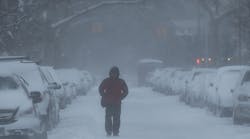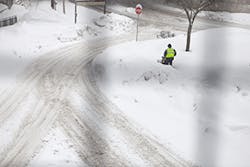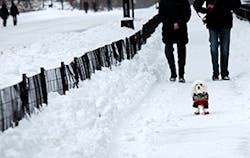Winter storm Jonas already has delivered on its promise of hazardous driving conditions and frigid temperatures across the plains, south and on to the East Coast. Depending on your location, the storm has resulted in ice accumulations, heavy snow and flooding. While mild temperatures have been the story for most of the winter, this “nor'easter” is a reminder to never underestimate winter storms.
Homeowners and business owners need to prepare for Jonas and the winter storms to follow and staying safe requires common sense as well as preparation.
Don't Get Buried – Prepare Early
While people rush to hardware and grocery stores after hearing a forecast for a winter storm, there is no need to wait until the last minute. It's a good idea to pick up essentials such as food right before a major storm, but preparing for the winter storm season requires being ready for every snow event, not just the big one. Dry air, drafty windows and automotive issues can spell trouble all winter long. Here some things families can do to get ready right now:
- Prepare for power failures: Stock up on batteries for flashlights and small lanterns. Also keep candles on hand as they provide light and some heat.
- Keep out the cold: Add insulation to water pipes to prevent freezing in a power outage. If you have pipes running along outside walls, turn them on to a slight drip to keep water flowing when temperatures fall. Increasing attic insulation and investing in new windows also helps keep warm air in and cold air out.
- Be ready to stay indoors: Winter often means spending increased time indoors. With the continued heating of the home, dry air can become a problem that leads to decreased comfort, health issues and damage to the home. Humidifiers are the most effective way to add moisture to a home’s air.
- Inspect your car: Maintaining tires and batteries are two of the best investments commuters can make in the winter. An engine that is slow to turnover is a major sign a battery is failing. However, a battery should be replaced or inspected after three years even if it appears to be working fine, according to Firestone. To check tire condition, use the penny test. Simply place a penny in the tread and if you can see all of Lincoln’s head, it’s time for a new set of all-season tires.
- Shop before the snow arrives: Even in northern parts of the country, homeowners often wait until a winter storm hits to check the snow blower or replace last year’s broken shovel. Purchasing or repairing these items early in the season can keep a family a step ahead when hazardous weather arrives, since stores struggle to keep these items on the shelf during a blizzard.
Power Outages
Due to the potential severe winter weather, there is also an increased likelihood of power outages. Consider these tips to keep your entire household safe and warm if the power goes off:
- Stay home!
- Stay off the roads during severe weather conditions but if you must drive, keep a disaster kit in your car that includes a flashlight; blankets; water; energy bars; extra socks, gloves and hats; and cardboard, so that you can drive over slick surfaces if you get stuck.
- In your home, have enough water and non-perishable foods for at least 72 hours.
- Have emergency supplies and refill your prescriptions before the storm hits.
- Close off unused rooms and wear layered clothing and use blankets or sleep bags to stay warm.
- Bring pets inside.
- Avoid using generators, outdoor heating or cooking equipment, such as a grill, camp stove or gasoline propane heater indoors.
- Remember that snow or debris can hide downed, live power lines. Be careful when walking around outside, particularly if you suspect some of the power lines around you are down.
Driving Safety
If you get stuck in bad weather while driving:
- Drive slowly and keep clear of snow plows.
- Wear layers of clothes to keep warm.
- Charge your cell phone before you leave and while driving and minimize usage.
- Try to keep a full tank of gas to avoid ice in the tank and fuel lines.
- Remember that experience, new tires and four-wheel drive are no match for completely iced-over roads and unprepared drivers. Everyone is at risk when the roads get bad.
Winter Preparedness for Your Business
If a winter storm should strike, do you have safeguards in place to protect your business and employees? Preparing your business for both short- and long-term interruptions is important. Additionally, business owners should consider having an action or communications plan for their employees.
In partnership with Agility Recovery, the Small Business Administration developed a checklist for business owners to consider when preparing their companies for emergencies and disaster recoveries. Here are some of their tips:
Before the Storm:
- Check your insurance coverage protection against winter hazards.
- Develop a procedure for restoring electrical services on an item-by-item basis.
- Develop a procedure for relocating salvageable and undamaged stock and supplies.
During the Storm:
- Keep driveways, walkways and doorways clear of snow and ice.
- Open water faucets to let them drip to keep water flowing through the pipes vulnerable to freezing.
- Have the names and phone numbers of your heating contractor, plumber, fire department, insurance agent and building owner accessible.
- If you have employees outside shoveling snow (or if you know they will be shoveling at home) remind them to take frequent breaks and drink plenty of fluids.
- They should warm up their muscles before shoveling with some stretches. Shoveling is strenuous exercise!
- Like any type of lifting, remind them to keep their backs straight and lift with their legs when shoveling, and remind them to shovel small amounts at a time, rather than trying to lift shovels loaded with 50 lbs of wet snow. Also, they should push the snow rather than lift it whenever possible.
- If they are removing snow from the roof, they should be using the same types of fall protection they would use for any work at heights. Remind them that ladder treads can be slippery when icy or wet. Seems like common sense, but we all forget to use common sense at times.
Slippery Surfaces
- Whether you are at work or at home or running pre- or post-storm errands, slippery surfaces can be extremely hazardous. Snow can cover icy sidewalks, and black ice is invisible.
- Wear insulated boots and footwear with non-slip soles.
- Clear sidewalks and walking surfaces and use ice melt so they don’t get slippery.
- To avoid wipeouts, take short steps and walk at a slower pace.
- If you’re walking in the street, walk against traffic and keep an eye out for out-of-control vehicles. If a vehicle loses traction, there isn’t much a driver can do to avoid you even if he or she sees you, so clear out of the way.
- If walking at night or during heavy snow, wear bright or reflective clothing if possible.
Utility crews in the states that will be impacted by the storm are on high alert, airlines are cancelling flights and train stations are shutting down. Stay home, stay warm and stay safe.






